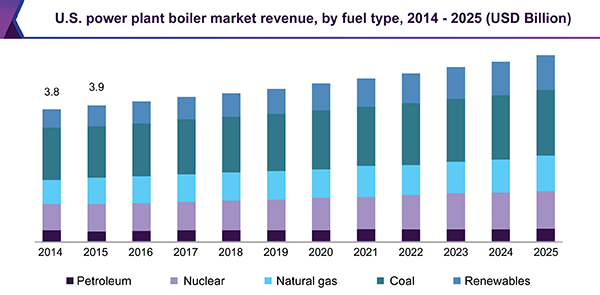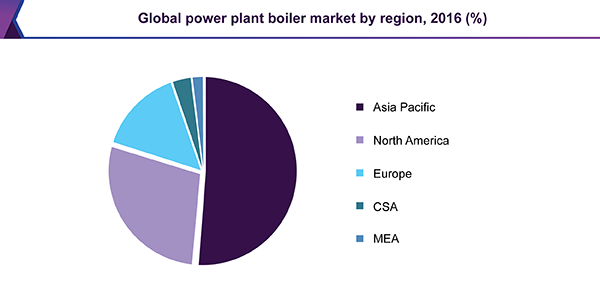- Home
- »
- Power Generation & Storage
- »
-
Power Plant Boiler Market Size & Analysis, Industry Report, 2014-2025GVR Report cover
![Power Plant Boiler Market Report]()
Power Plant Boiler Market Analysis By Process (Pulverized Fuel Combustion, Fluidized Bed Combustion), By Technology (Subcritical, Supercritical, Ultra-critical), By Region, And Segment Forecasts, 2018 - 2025
- Report ID: GVR-2-68038-852-7
- Number of Pages: 110
- Format: Electronic (PDF)
- Historical Range: 2014 - 2015
- Industry: Energy & Power
Industry Insights
The global power plant boiler market size was valued at USD 19.8 billion in 2016. Factors such as government-led initiatives and the rising energy demand are likely to be key drivers for the product demand over the forecast period. Furthermore, technological advancements are likely to fuel market growth.
The demand for the product in the U.S. is dominated by the growth in the per capita power consumption. The U.S. has witnessed tremendous growth in its power consumption. The electric power consumption in the country increased from 9,862.3-kilowatt-hour per capita in 1980 to 12,986.7-kilowatt-hour per capita by 2014.

The increasing dependency on electronic gadgets such as smartphones, smart automation, and others is likely to fuel the demand for power in the coming years. The growing power requirement is expected to provide a steady demand for the product over the predicted period. The mature U.S. market is witnessing a shift in the type of fuel used for power generation.
The country is opting for cleaner sources to generate power. The renewable sources of fuel are gaining popularity among investors. This, in turn, has led to the growth of renewable fuels to generate electricity as they are profitable in terms of cost, efficiency, and economies of scale. The country is witnessing the shutdown of coal plants to cut down on carbon emissions. Another reason for the shift is the availability of cheap natural gas, which provides better opportunities for the operators concerning the production cost.
The U.S. government is planning to withdraw its largest coal-fired plant in Massachusetts, U.S.A. similar trend has been observed in Maryland, U.S., where the state government is planning to reduce its dependency on coal-based power by nearly 22% by 2020. The U.S. government plans to raise tax credits for plants, which efficiently dispose of carbon emissions. The carbon tax bill proposed by the U.S. is expected to increase tax credits for power plants from USD 20 per ton to USD 50 per ton of carbon. The plants that use carbon emission to stimulate oil production are likely to credit raise from USD 10 per ton to USD 35 per ton.
Process Insights
The pulverized fuel combustion (PFC) process is likely to emerge as the highest-grossing segment over the forecast period. The process captured a market share of nearly 55% in 2016. The process is universally adopted for large-scale power plants. The pulverized fuel combustion process includes powdered coal, which is used to increase the exposure area of combustion. The powdered form of coal is blown into the furnace by using hot air, secondary air is provided in the combustion chamber to allow complete combustion of the fuel. The turbulence caused by the secondary air enables the uniform mixing of air and fuel. Therefore, the resultant of this process allows combustion at a faster rate with higher efficiency.
The fluidized bed combustion (FBC) process is widely adopted by boiler manufacturers. The fluidization process is defined as a procedure to mix air and fuel in defined proportion to obtain complete combustion of solid particles. The high velocity of air results in the turbulence and swift mixing of solid particles, which appear like a bubble in a boiling liquid, and thus, the process of combustion is known as the fluidized bed combustion. The process is gaining prominence in the market as it allows liquid waste to be used for the heat treatment process. Therefore, the process is widely adopted by operators to provide energy from liquid waste.
The advancements in the process to increase efficiency and reduce carbon emissions are likely to drive the market toward innovation. The increasing power consumption is anticipated to be the key driver for innovation. The manufacturers of boilers are investing heavily in the research and development of new processes to enhance efficiency. Moreover, the increasing concerns regarding the environment are likely to be a threat to the product over the forecast period. However, this constraint is anticipated to be short term. The U.S. Environmental Protection Agency seeks to revive the coal sector in the U.S. Therefore, government support toward the industry is directly linked to market growth.
Technology Insights
The subcritical segment is likely to be the most dominating technology over the forecast period. The share of this technology is likely to increase from 73.9% in 2016 to 74% by 2025. The growth can be attributed to the dependency on coal for power generation. The number of coal-based power plants is increasing at a modest rate, especially in the developing economies. The easy availability and low input costs are likely to be the key drivers for the growth of the segment over the predicted timeline.
The supercritical segment is likely to observe the highest growing CAGR over the forecast period. The technology is becoming widely popular, especially in OECD countries and China. China has tremendously increased its power generation capacity from supercritical boiler technology. The country has nearly 23 supercritical units, which roughly provide 16MW of power. The high efficiency obtained by this technology is the key feature responsible for the segment growth.
The ultra-critical technology provides higher efficiency of nearly 50%, which is the highest among various types of technologies available for power generation via boilers. The cost of production through this technology is high in comparison to other technologies. There are roughly 26 operating units of ultra-critical technology in countries such as Japan, Denmark, Germany, the Netherlands, and the U.S.
Fuel Type Insights
Coal is the major source of fuel-type used for power generation and roughly accounts for 40% of the global energy generation. The use of coal is likely to increase in the coming years despite concerns over high carbon emissions. Governments across the world are looking for various alternatives to limit pollution caused due to coal by adopting efficient technologies. Thus, it is required that the industry and government embrace new technologies to ensure the usage of coal as a cleaner source of energy in the coming years.
The growing demand for nuclear fuel indicates that the world is shifting toward efficient methods for electricity generation. Nuclear power roughly contributed about 11% of the global power generation as of 2016 and the share is likely to increase in the coming years. The key driver for the segment growth is zero-emission associated with nuclear power generation. It is expected that the share of the nuclear fuel segment is estimated to grow over the forecast period.
The growth in renewable fuel sources suggests the shift in fuel usage paradigm for energy generation. The rising emphasis to control carbon emissions is driving the demand for renewable fuels. The trend is expected to continue over the forecast period as a large number of countries have submitted their intended Nationally Determined Contributions (INDCs) to cut down greenhouse gas emissions in accord with the Paris Summit 2015.
Regional Insights
APAC is likely to dominate the global market. The region is expected to grow from 51.4% in 2016 to 55.0% by 2025. Currently, APAC is experiencing a huge demand for the product and is witnessing growth potential as power consumption in the region is growing at an exponential rate. The rapid urbanization in the region is a key driver for growth.

India and China are likely to observe the highest growth in the urban population. For instance, as per the 2014 UN report, China and India were the top two countries in terms of population. China’s population was around 1.4 billion, out of which 56% resided in urban areas. In India, about 33% of the total population of 1.3 billion reside in urban areas. All these factors are expected to boost product demand over the forecast period. The increasing urban population coupled with the rising strain on the current power capacity is expected to fuel the market over the forecast period.
Rapid industrialization and the growing transportation sector in India and China are estimated to raise energy demand. Both countries aim to introduce electric vehicles in the respective nations to cut down on carbon emissions. The central government in China provides a special subsidy to the manufacturers of electric vehicles and plug-in hybrid cars to promote the sale of electric vehicles in the country. Factors such as government-led initiatives to push electric vehicles in the market are likely to further strain power resources, thus, leading to the demand for excess power.
Competitive Insights
The market is witnessing a change in the market dynamics as the market is moving toward globalization. The boiler manufacturers are branching out into the global market, especially in the developing economies. The rising globalization in the market has created new challenges for market vendors. The companies operating in the market are required to manage the supply chain to remain competitive. Besides, the manufacturers should remain competitive while adhering to the norms and policies set to design or manufacture boilers.
Key players include Babcock & Wilcox Enterprises; Dongfang Electric Corporation (DEC); Siemens AG; Mitsubishi Heavy Industries Ltd.; and General Electric (GE). Mergers of major players in the industry are likely to consolidate the industry in the predicted timeline. The dynamics suggest vendors focus on the research and development of the new technologies to limit the emissions.
Report Scope
Attribute
Details
The base year for estimation
2016
Actual estimates/Historical data
2014 - 2015
Forecast period
2017 - 2025
Market representation
Revenue in USD Million & CAGR from 2017 to 2025
Regional scope
North America, Europe, Asia Pacific, CSA, and Middle East & Africa
Country scope
U.S., Canada, UK, Germany, France, Japan, China, India, Saudi Arabia, and Brazil
Report coverage
Revenue forecast, competitive landscape, growth factors, and trends
15% free customization scope (equivalent to 5 analyst working days)
If you need specific market information, which is not currently within the scope of the report, we will provide it to you as a part of customization
Segments Covered in the reportThis report forecasts revenue growth and provides an analysis of the latest trends in each of the sub-segments from 2014 to 2025. For this report, Grand View Research has segmented the global power plant boiler market on the basic process, technology, fuel type, and region:
-
Process Outlook (Revenue, USD Million; 2014 - 2025)
-
Pulverized fuel combustion
-
Fluidized bed combustion
-
Others
-
-
Technology Outlook (Revenue, USD Million; 2014 - 2025)
-
Subcritical
-
Supercritical
-
Ultra-critical
-
-
Fuel type Outlook (Revenue, USD Million; 2014 - 2025)
-
Petroleum
-
Nuclear
-
Natural gas
-
Coal
-
Renewables
-
-
Regional Outlook (Revenue, USD Million; 2014 - 2025)
-
North America
-
U.S
-
Canada
-
-
Europe
-
Germany
-
France
-
UK
-
-
Asia Pacific
-
China
-
Japan
-
India
-
-
Latin America
-
Brazil
-
-
The Middle East and Africa
-
Saudi Arabia
-
-
Share this report with your colleague or friend.
![gvr icn]()
NEED A CUSTOM REPORT?
We can customize every report - free of charge - including purchasing stand-alone sections or country-level reports, as well as offer affordable discounts for start-ups & universities. Contact us now
![Certified Icon]()
We are GDPR and CCPA compliant! Your transaction & personal information is safe and secure. For more details, please read our privacy policy.
We are committed towards customer satisfaction, and quality service.
"The quality of research they have done for us has been excellent."





